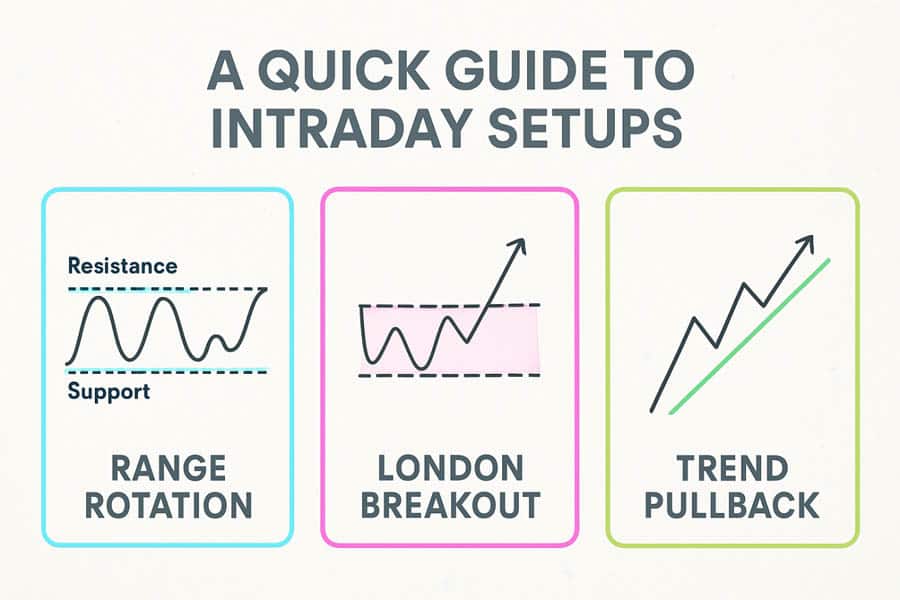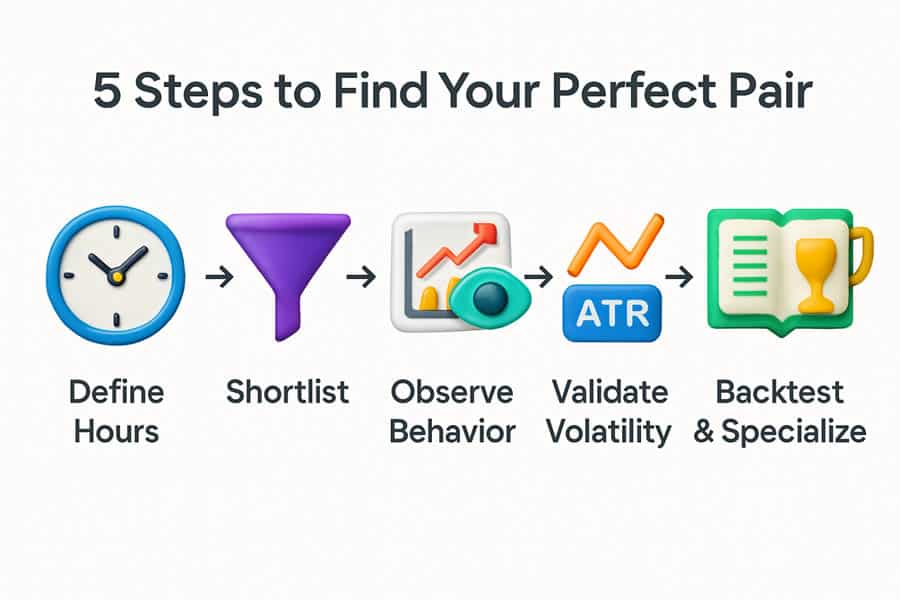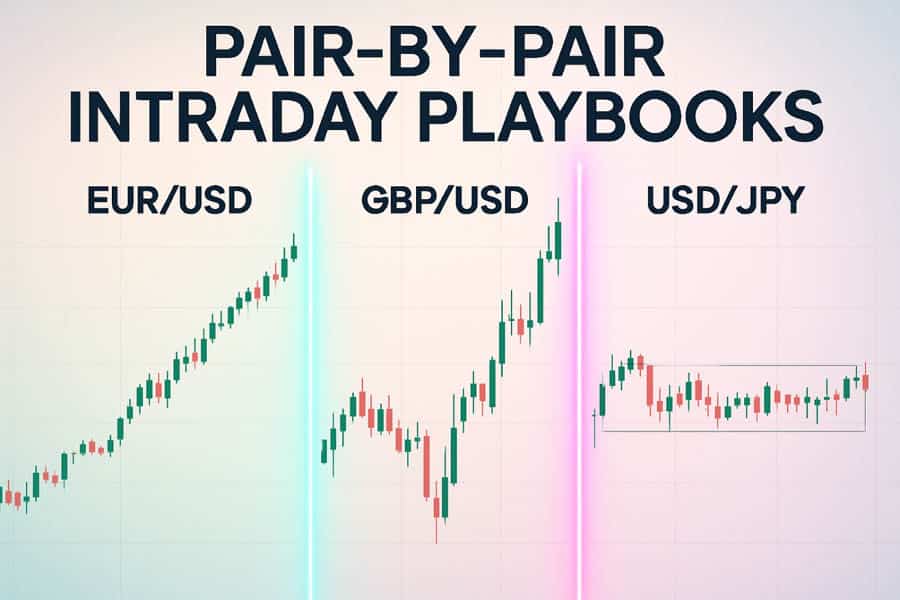The best pairs for day trading are typically the major forex pairs like EUR/USD, USD/JPY, and GBP/USD. Their high liquidity and predictable behavior during peak market hours offer the most reliable opportunities. However, the true “best” pair depends entirely on your trading strategy, the session you trade, and your risk appetite. As a trader, finding a great, regulated forex broker is your first step, but mastering which currencies to trade is what will define your journey. This guide moves beyond simple lists to give you actionable, experience-based playbooks for matching the right pairs to the right setups.

Key Takeaways
- Session Is Everything: The most active and opportune time for day trading is the London session and the London-New York overlap (8 AM to 4 PM GMT). The highest volume and movement occur here.
- Start with Majors: For most traders, the best pairs for day trading are the majors: EUR/USD, USD/JPY, GBP/USD, and USD/CHF. They offer tight spreads, deep liquidity, and cleaner reactions to technical levels.
- Volatility for Experts: High-volatility pairs like GBP/JPY, GBP/AUD, and exotics like USD/ZAR offer larger profit potential but come with wider spreads and higher risk. They are best suited for experienced traders with solid risk management.
- Match the Pair to Your Setup: Don’t trade every pair the same way. Range-trading strategies fit pairs like USD/JPY and USD/CHF, while breakout and trend-following strategies are better suited for GBP/USD and EUR/USD.
- Risk Comes First: Use the Average True Range (ATR) indicator to measure a pair’s volatility. This allows you to set appropriate stop-losses and profit targets, normalizing your risk across different pairs.
Best Pairs for Day Trading (At-a-Glance)
Before we dive deep, let’s get straight to the point. If you’re looking for a quick answer, these are the pairs I’ve found to be the most consistent for intraday strategies. I’ve spent years observing their personalities, and each one has its own rhythm. This table summarizes the best forex pairs for day trading and their core characteristics.
| Currency Pair | Key Characteristic | Best Trading Session(s) | Ideal for Setup |
| EUR/USD | High liquidity, tight spreads, clean technicals | London, London/NY Overlap | Breakouts, Trend Following |
| USD/JPY | Reliable ranges, respects technical levels | Tokyo, London | Range Trading, Breakouts |
| GBP/USD | Higher volatility, news-driven momentum | London, London/NY Overlap | Breakouts, News Trading |
| USD/CHF | Safe-haven, often ranges cleanly | London, New York | Range Trading, Reversals |
| AUD/USD | Commodity-driven, clear trends | Tokyo, London | Trend Following, Pullbacks |
| GBP/JPY | Extreme volatility, large intraday swings | London, London/NY Overlap | Momentum Trading |
| USD/CAD | Oil-correlated, news sensitive | New York | News Trading, Trend Following |
What Makes a “Best Pair” for Day Trading?

New traders often hunt for a single “magic” pair. The reality is that the best pairs for day trading are not universal; they are the ones that align perfectly with your trading plan. What works for a scalper in the Tokyo session will be disastrous for a trend follower during the New York open. The criteria that matter are objective and measurable. Let’s break them down from an experienced trader’s perspective.
Start with the Best Trading Times
Your number one filter should be time. If a pair isn’t moving, you can’t make money. The forex market operates 24 hours a day, but it’s driven by three main sessions: Tokyo, London, and New York. The real magic for day traders happens when these sessions overlap, as this is when liquidity and volatility spike. The London-New York overlap (approximately 8:00 AM to 12:00 PM New York time) is often called the “golden hours” for a reason. This is when the world’s two largest financial centers are active, leading to significant price moves in pairs like EUR/USD, GBP/USD, and USD/CHF. The London session is, by itself, the most volatile, making it a prime hunting ground. Focusing your energy here is the single best decision you can make.
Criteria Tied to Day-Trading Setups
Once you’ve identified your trading window, you can filter for pairs using these critical factors. This is how you find the best currency pairs to day trade for your specific style.
- Liquidity and Spreads: Liquidity is the ability to buy or sell a pair without causing a major price shift. For day traders, high liquidity is non-negotiable. It means you get your orders filled at the price you expect (or very close to it) and that the transaction cost (the spread) is low. The major pairs (EUR/USD, USD/JPY, GBP/USD, USD/CHF) are the champions here. Trading a pair with low liquidity means wider spreads and a higher chance of slippage, which eats away at your profits before you even have a chance.
- Intraday Volatility (ATR): Volatility is a day trader’s best friend, but it’s a double-edged sword. You need enough movement to hit your profit targets, but not so much that you get stopped out by random noise. This is where the Average True Range (ATR) indicator is invaluable. It tells you the average trading range of a pair over a specific period. For example, if GBP/JPY has an ATR of 150 pips and USD/CHF has an ATR of 50 pips, you know that you need to give the former more room to breathe with a wider stop-loss. The best forex pairs for day trading have a predictable and manageable ATR for your strategy.
- News Sensitivity: Some pairs react violently to economic news, while others barely flinch. Major pairs like EUR/USD and GBP/USD are very sensitive to high-impact news releases like Non-Farm Payrolls (NFP) or inflation (CPI) data from the US, UK, and Eurozone. This can be an opportunity for news traders but a hazard for technical traders who might see their setups invalidated in a heartbeat. Knowing a pair’s personality during news events is crucial.
- Technical “Respect”: This is a more subjective trait, but one that I’ve come to value immensely. Some pairs just seem to “respect” technical levels like support, resistance, and trendlines more cleanly than others. From my experience, USD/JPY and EUR/USD often provide very clean chart patterns and reactions to key levels. In contrast, cross-pairs like GBP/AUD can be much choppier and less predictable, often overshooting levels before reversing. The best pairs for day trading are often those that behave in a structured, predictable manner.
A Quick Guide to Intraday Setups

Your strategy dictates your choice of currency pair. You wouldn’t use a hammer to turn a screw. Similarly, you wouldn’t try to trade a tight range on a wildly volatile pair. Here are the common intraday setups and the types of pairs they are suited for. Understanding this connection is key to finding your personal best pairs for day trading.
- Range Rotation: This strategy involves identifying a clear support and resistance level and trading between them—selling at the top and buying at the bottom. It works best in low-volatility environments or on pairs that tend to consolidate, like USD/JPY and USD/CHF during the quieter parts of the London session.
- London Breakout: A classic day trading strategy. During the Asian session, pairs like EUR/USD and GBP/USD often form a tight range. The strategy is to wait for the London open, which brings a surge of volume, and trade the breakout of that Asian range. It’s a powerful momentum-based setup.
- Trend Pullback: When a pair is in a strong intraday trend, you don’t want to chase the price. Instead, you wait for a temporary pullback to a key level (like a moving average or a previous support level) and then enter in the direction of the trend. This works well on trending pairs like AUD/USD or EUR/USD on days with a clear fundamental driver.
- High-Volatility Momentum: This is for the adrenaline junkies. On pairs known for massive swings, like GBP/JPY (“The Dragon”) or GBP/AUD, the strategy is to catch and ride strong, impulsive moves. This requires very tight risk management, smaller position sizes, and the experience to handle potential slippage. This is where finding the best currency pairs to day trade can mean finding the most active ones.
How to Find Your Best Pair for Day Trading

Finding your niche is a process of elimination and self-awareness. It’s about building a specialized skill set rather than being a jack-of-all-trades. After years of trading, I’ve refined this into a simple, five-step process that any trader can follow to discover their own best pairs for day trading.
- Step 1: Define Your Trading Hours: Be realistic. When can you be at your desk, focused and undisturbed? Your answer immediately narrows the field. If you can only trade during the New York session, your focus should be on USD-based pairs. If you’re available for the London open, GBP and EUR pairs are your prime candidates.
- Step 2: Shortlist Your Candidates: Start with the majors. They are the most forgiving for new traders due to their liquidity and low spreads. Pick 2-3 majors that are active during your trading window. If you are an experienced trader, you can add one high-volatility cross-pair to your watchlist, like GBP/JPY or EUR/AUD, but don’t overdo it.
- Step 3: Match Setups to Pair Behavior: Now, watch them. Don’t trade, just observe. Does EUR/USD tend to trend cleanly after the London open? Does USD/JPY respect its Asian session range? Take notes. See if the strategies you want to use (range, breakout, trend) align with the pair’s actual behavior. This is a critical step in identifying the best forex pairs for day trading for you.
- Step 4: Validate with ATR: Check the Average True Range for your shortlisted pairs. Is the daily range large enough to offer good risk/reward opportunities (e.g., at least 50-60 pips)? Is it too large for your risk tolerance? Adjust your expectations or your pair selection accordingly.
- Step 5: Backtest and Specialize: Once you have 2-3 potential pairs, focus exclusively on them. Journal every trade. Note the session, the setup, and the outcome. Over time, patterns will emerge. You might find you are incredibly profitable trading GBP/USD breakouts but lose money on USD/JPY ranges. This data-driven feedback will reveal your true best pairs for day trading.
Pair-by-Pair Intraday Playbooks

Theory is one thing; practical application is another. Here are my personal, experience-driven playbooks for some of the best pairs for day trading. This isn’t just about what the books say; it’s about how these pairs behave in the real world, in the heat of the moment.
EUR/USD: The People’s Pair
Why I like it: It’s the most traded pair in the world for a reason. Its deep liquidity means what you see is what you get. Spreads are razor-thin, and the chart structure is often incredibly clean. It’s the benchmark against which I measure all other pairs. It’s one of the best forex pairs for day trading for both beginners and pros.
Best Sessions: London open and the London-New York overlap. This is when it comes alive.
Best Setups:
- London Breakout: A textbook setup. I look for the consolidation during the late Asian session and place my orders based on the break of that range shortly after the London market opens.
- Trend Pullbacks: On days when there’s a clear directional bias from ECB or Fed commentary, I wait for pullbacks to the 21 EMA on the 15-minute chart. It’s a simple but effective way to join a moving train.
USD/JPY: The Technician’s Dream
Why I like it: This pair has a personality that respects technical analysis. It tends to form clean ranges and channels, making it one of the best currency pairs to day trade for systematic traders. It’s also influenced by risk sentiment, acting as a safe haven, which adds another layer to its analysis.
Best Sessions: It’s active in Tokyo, but I find the best opportunities often come in the London session when it either breaks out of its Asian range or continues to respect it.
Best Setups:
- Range Rotation: If the pair is stuck between clear support and resistance, especially pre-London, fading the edges can be very profitable. I look for confluence with RSI divergence to confirm entries.
- Yield-Driven Breakouts: Keep an eye on the US 10-year Treasury yield. When yields are moving decisively, USD/JPY often follows. A breakout on the yield chart can signal a pending breakout on the pair itself.
GBP/USD: The Mover and Shaker
Why I like it: When you want movement, you trade “Cable.” Its volatility is higher than EUR/USD, meaning bigger swings and more opportunities in a shorter time frame. It reacts strongly to news from both the UK and the US, making it one of the best pairs for day trading during high-impact data releases.
Best Sessions: The London open is its prime time. The volatility that hits right at the open is famous. The London/NY overlap is also a hotspot.
Best Setups:
- News Breakout: I don’t trade *through* the news, but I trade the reaction. I wait for a release like UK CPI or US NFP, let the initial spike happen, and then trade the secondary momentum leg on a 5-minute chart. This requires a solid plan and discipline.
- London Open Breakout: Similar to EUR/USD but with more power. The initial move can be explosive. I use the ATR to set a wider stop-loss to avoid getting shaken out by the noise. This makes it a contender for the best currency pairs to day trade if you can handle the volatility.
High-Volatility Crosses: For Experts Only
Pairs like GBP/JPY, GBP/AUD, and AUD/JPY are in a different league. They are not for the faint of heart. While they can offer incredible rewards, the risks are magnified. I only recommend these to traders who have consistent profitability on the majors first. If you venture here, remember two rules: cut your position size in half, and always use a hard stop-loss. Their wild swings make them some of the best forex pairs for day trading for pure momentum strategies, but they can wipe out an unprepared trader’s account swiftly.
Risk and Execution for Day Traders

Discussing the best pairs for day trading is meaningless without a robust conversation about risk. The most profitable setup on the perfect pair will fail if you don’t manage your risk correctly. Over the years, I’ve learned that survival, not profit, is the number one priority. Profitable trading is the byproduct of excellent defense.
- ATR-Calibrated Risk: Never risk a fixed number of pips. Risk a fixed percentage of your account (e.g., 1%) on every trade. Use the pair’s ATR to determine where your stop-loss should be placed. A volatile pair like GBP/JPY needs a wider stop than a quieter pair like USD/CHF to account for its normal daily movement. This standardizes your risk across all trades.
- Correlation Management: Be aware that many pairs move together. EUR/USD and GBP/USD are positively correlated (they tend to move in the same direction), while EUR/USD and USD/CHF are negatively correlated. If you take a long trade on both EUR/USD and GBP/USD, you are not diversifying; you are doubling down on a single idea (USD weakness). Know these correlations to avoid unintentional over-exposure.
- Have a News Protocol: High-impact news can turn a winning day into a losing one in seconds. My rule is simple: I am flat (out of all positions) in the 15 minutes before and after a major, red-flag news event like a central bank decision or NFP. I let the dust settle and then analyze the new landscape. The best pairs for day trading can become the most dangerous during these moments.
Your Platform for the Best Pairs
Opofinance, a regulated forex broker under ASIC, provides the ultimate environment for trading the best pairs for day trading. They empower traders with a suite of advanced tools and secure platforms.
- Advanced Trading Platforms: Choose from MT4, MT5, cTrader, and the proprietary OpoTrade platform to match your trading style.
- Innovative AI Tools: Gain a competitive edge with an AI Market Analyzer, an AI Coach for performance feedback, and 24/7 AI Support.
- Versatile Trading Options: Explore opportunities in Social Trading and Prop Trading to diversify your strategies.
- Secure & Flexible Transactions: Enjoy peace of mind with safe and convenient deposits and withdrawals, including crypto payments with zero fees.
Start Trading with Opofinance Today!
Conclusion
The quest for the best pairs for day trading ends with a simple truth: the best pair is the one you understand inside and out. It’s not about a secret list; it’s about specialization. By aligning your chosen pair with the right session, the right strategy, and rigorous risk management, you create a professional trading process. Start with the majors, learn their personalities, master one or two setups, and you will have found your personal best pairs for day trading—the ones that consistently work for you.
How many currency pairs should I focus on as a day trader?
Most successful day traders specialize in just 2-4 pairs. This allows you to learn their specific behaviors, volatility patterns, and reactions to news events intimately. Quality over quantity is key.
Are minor currency pairs good for beginners?
Generally, no. Minor pairs (crosses that don’t include the USD, like EUR/GBP or AUD/NZD) typically have lower liquidity and wider spreads than the majors. This makes them more expensive to trade and less forgiving for new traders.
What is the single most important factor in choosing a pair?
Session timing. A pair is only as good as the volatility it provides during your available trading hours. If you trade a pair when it’s dormant, even the best strategy will fail. Always prioritize pairs that are active when you are.
Can I make a living day trading just one pair?
Absolutely. Many professional traders specialize in a single pair, like EUR/USD or GBP/USD. By mastering one instrument, they develop an expert feel for its rhythm and patterns, which can be a significant edge.
How does volatility differ from liquidity?
Liquidity refers to how easily a pair can be bought or sold without affecting its price. High liquidity means many buyers and sellers. Volatility refers to how much the price moves over a period. A pair can be highly liquid but have low volatility (like EUR/USD during the Asian session), or vice-versa, though this is less common.







